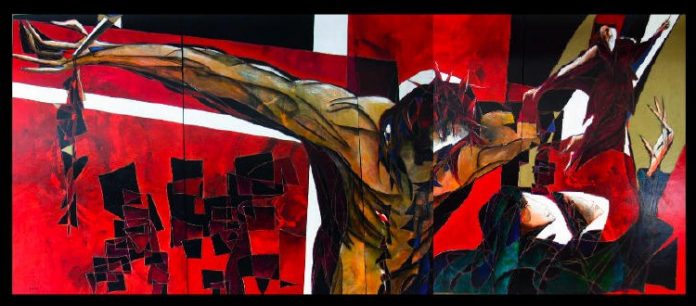Jean-Claude Gaugy’s painting There is No Death (Il n’y a pas de mort) has become a much-loved often-studied piece in the Jesuit school community. “I have closely observed the piece many times,” says Joe Tom Hood, ’12, “and I believe it shows that Jesus Christ gave his life for our sins.”
Indeed, art and theology classes alike tour the Jesuit Dallas Museum and examine There is No Death, which hangs at the center of the Terry Center entrance. Chris Steiner ’12 comments: “I really appreciate the contrast of colors between the vibrant reds which show fiery painful death and the black, sinister colors which show that it is a dark time. I have spent many early mornings and free periods observing the piece, and it is my favorite work of art.”
Jean-Claude Gaugy was born in the Jura Mountains near West France in 1944. He came from a family with a rich tradition of four centuries of artisanship. At the age of 14, he decided to leave his hometown and migrate to Paris. There, he started painting in cafes where one day he was approached by the owner of a dining club to paint portraits of the club’s members. Later, a man named Salvador Dali walked into the dining club and spotted Gaugy’s works. He was so impressed by the art that he did an exhibition for him so that everyone would be able to see his amazing works. Before long, Jean-Claude Gaugy became a famous international artist.
Gaugy loved painting so much that he went on to study classical arts at the École des Beaux. He believed there was an underlying unity in the universe. Gaugy represented the vibrant spirit of the human soul with vivid colors and textured strokes. The artist strove, above all, to be a student of art and the expression of human emotions. He was so consumed with learning more about the art of painting that he attended other schools in Paris, Rome, Germany, Moscow, and England. In 1966, he journeyed to the United States which led to his new style named Linear Expressionism. With the help of his acclaimed attribute of excelling in sculpting and painting, he created this new style, drawing a rhythmic, flowing, but articulate line into wood and finishing off by complementing movement with color. During his time in the U.S., he built murals like the Rockefeller Foundation, New York’s Columbian Presbyterian Medical Center, and the National Foundation for Depressive Illness. Some of his works are located at the Smithsonian Institution in Washington, D.C and some private collectors are former President Bill Clinton and his wife as well as the President of Turkey and his wife.
Through a generous donation in 1997, Jesuit College Preparatory of Dallas acquired Jean-Claude Gaugy’s amazing There is no Death (Il n’y a pas de mort). The painting captures the eye with its exuberant color schemes which the artist incised into the wooden material used in the painting. In the painting itself, a wash of red personifies the aspect of sin and blood, but where Jesus stands, we see some blue and white which reminds us of rebirth. To Christ’s left, we see two women who appear to be raising their hands. They each carry green dresses which might be to remind us of hope as they raise their hands. And finally at the top right, we see a human-like figure which seems to be levitating above the ground. The artist seems to show Jesus’ suffering as a tragic but necessary part of his life; Gaugy shows His death, not as an end to life, but as a part of His glorious ascension into heaven.
Source: http://www.sacreddancinggallery.com/jean-claude-gaugy/biography.html
Source: Jesuit Museum Club






